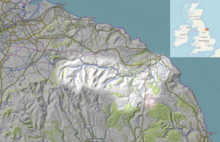River Esk (North Sea)
| River Esk | ||
|
Aerial view of Whitby with the Esk Estuary |
||
| Data | ||
| location | North York Moors , North Yorkshire , England | |
| River system | Esk | |
| River basin district | Humber | |
| Headwaters |
Westerdale Moor 54 ° 24 ′ 3 ″ N , 0 ° 59 ′ 8 ″ W. |
|
| muzzle | at Whitby in the North Sea Coordinates: 54 ° 29 ′ 33 " N , 0 ° 36 ′ 44" W 54 ° 29 ′ 33 " N , 0 ° 36 ′ 44" W
|
|
| length | 45 km | |
| Catchment area | 362 km² | |
The River Esk is a river in the North York Moors in North Yorkshire , England .
location
The 45 kilometer long Esk drains an area of 362 km². It flows from a series of springs on Westerdale Moor through the Esk Valley eastwards until it flows directly into the North Sea at the port of Whitby - the only major river in Yorkshire at all . All of the other Yorkshire rivers flow directly or indirectly into the Humber . The Esk Valley is the only west-east trending valley in the North York Moors.
geology
The river flows through Jurassic sandstone and lias to the North York Moors. The water quality is due to its remoteness in the upper range. Some tributaries, however, sometimes have biologically difficult conditions due to strongly acidic inflows from the moor areas. Around 50 percent of the catchment area consists of moorland and heathland, which is primarily used for grouse hunting and is extensively grazed by sheep. The other half consists mainly of agricultural land, here almost exclusively grazing.
Biodiversity
The Esk is the only river in Yorkshire where salmon and sea trout live. In addition, endangered species include otters , the eastern water vole , kingfisher , dipper and river pearl mussel . Although water pollution has decreased since the 1970s, the decline in fish stocks continues. The most likely cause for this is the continued shrinking habitat and spawning area in the river area. Fishing in the river has been possible since 1200 BC. It is best known for sea trout and salmon, but brown trout and grayling are also fished today.
tourism
Due to its location in the national park, the Esk is a popular travel destination. In the 1990s, a good four million tourists came to the Esk Valley annually, mainly to enjoy the landscape.
The long-distance hiking Esk Valley Walk runs in parts beside the river here, a few kilometers of the Coast to Coast Walk also follow the Eskdale in the middle section.
literature
- North York Moors National Park Authority: River Esk Regeneration Program July 1997 – October 2001 . 2001 ( as pdf )

